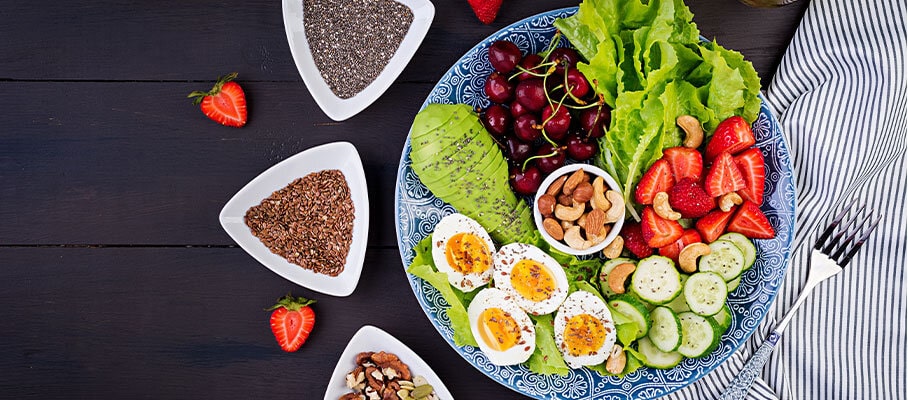Disease
Top Tips from Nutritionist to Control your After Meal Blood Sugar Levels
4832 Views
0

I don’t eat sweets too often, where does this blood sugar come from?
Blood sugar, or blood glucose comes from the food you eat, and is your body's main source of energy. It is not just the sweet food items, everything that you eat gets converted to glucose. Your blood carries glucose to all the cells in your body to be used for energy. When your blood sugar level is too high, it results in diabetes. Over time, having uncontrolled blood sugar can lead to serious problems. Even if you don't have diabetes, sometimes you can have problems with blood sugar that is too low or too high. Keeping a regular schedule of eating, activity and taking appropriate medications can help.
It is crucial to keep your blood sugar numbers within your target range. You may need to check your blood sugar regularly to know if you are under control. Your health care provider will also do a blood test called the glycated hemoglobin or HbA1c. It checks your average blood sugar level over the past three months.
Does the after-meal blood sugar really matter?
Most diabetics measure their fasting blood sugar levels, however, they miss on testing sugar values after meals. If you’re not testing how your food is impacting your blood sugar, you’re missing the full picture. Post meal or post prandial blood sugar levels provide important information about how your body is able to manage glucose after a meal. If you are taking care of your diabetes correctly, the blood glucose will return to normal after the meal intake.
Quick fact
Blood sugar levels begin to rise about 10 minutes after the start of a meal and peak two hours after a meal. It then returns to before-meal levels within two to three hours.”
By checking your post meal sugar, your doctor and your dietitian can determine whether before-meal insulin or dietary modifications is needed to reduce these sugar spikes.
Book your post meal sugar test here.
This is what nutritionists advice to control your after-meal blood sugar levels:
- Do not skip breakfast: Do you often miss taking your morning snack and breakfast in a hurry to get to work or amid other household chores? A study shows that people with diabetes who skip breakfast have higher blood sugar after lunch and dinner.
- Watch what you eat: If you are someone who has controlled pre-meal glucose targets but your HbA1c remains above target, after meal glucose tracking and control becomes important.
-Opt for non starchy foods: Non starchy foods have less carbs and are full of vitamins and minerals which help to regulate your sugar level. Some examples of non-starchy foods include broccoli, cabbage, cauliflower, avocados, cucumbers, green beans, olives, onion, tomatoes etc.
-Include green leafy vegetables: Green leafy vegetables like spinach are rich in fibers and prevent random sugar spikes. Leafy greens also contain specific antioxidants that help protect your eyes from complications of diabetes.
-Go nuts: It helps to control your blood sugar levels. Nuts contain high levels of fiber and have low-digestible carbs that do not allow your blood sugar level to rise. Walnuts and almonds could be your pick in the evening snack.
-Eat seeds: Chia seeds and flax seeds can be added to your morning breakfast. Chia seeds are full of fiber, low in digestible carbs, and have been found to lower your blood sugar levels in some studies. Flax seeds are also beneficial because they can help improve blood sugar control, may reduce the risk of heart disease, and reduce the chance of having a stroke.
-Explore the power of spices: Cinnamon and garlic have been used for a long time in our traditional medicine.They contain natural compounds that help balance sugar levels.
- Take your medicines on time: The right insulin or medicine program can make a big difference. Your doctor can explain your options in a nuanced way. Never miss a dose and adhere to your dosing schedule.
- Go for an after-dinner walk: It is considered a healthy habit for everyone as it prevents acidity. But if you have diabetes, it's also a good way to burn extra glucose from a meal.
Who should test post meal blood sugar more often?
Some people should test PPG and blood sugar levels more frequently as per the American Diabetes Association (ADA), including:
- Pregnant women with gestational diabetes
- Women with type 1 or 2 diabetes who are pregnant
- People provided with a new insulin or a new insulin dosage
- People with diabetes that’s hard to control
- People with history of high blood sugar after eating
- People who take multiple medicines and are at risk for high or low blood
Diabetes is affecting even young adults. It is important to learn some ways to recover from it in the early stages. If we follow these lifestyle rules properly, we can keep the blood sugar level in the best balance. Do not ignore symptoms, get tested and consult your doctor as soon as possible.













1701259759.webp)









 WhatsApp
WhatsApp